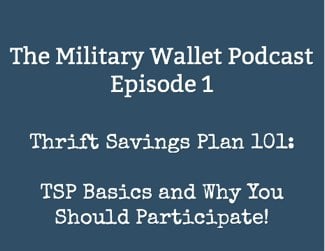 Military members and many government employees have access to pension plans, which are fast becoming hard to find in the civilian sector. But even if you qualify for a pension plan, will it be enough to finance your retirement? Or will you need additional savings and investments?
Military members and many government employees have access to pension plans, which are fast becoming hard to find in the civilian sector. But even if you qualify for a pension plan, will it be enough to finance your retirement? Or will you need additional savings and investments?
The answer, as you have probably guessed, is most people will likely need more money to fund a lifestyle that is equivalent to their current way of life. That’s where other retirement plans come into play. The most notable among these for military members and government employees are the TSP and individual retirement accounts.

The TSP and IRAs are both great options for investors. This podcast walks you through the basics of these plans. Our guest, Robert Shaye, an active-duty Coast Guard member and a recent MBA graduate from UC Berkeley Haas. Shaye shares some excellent information about the TSP and investing. He explains how you can accomplish your retirement goals.
Covered in this episode are topics including:
- Why you should save for retirement.
- How Shaye helped a friend put over $450,000 back in her pocket by making some small changes to her retirement account.
- What the differences between the TSP and IRAs are.
- What the difference between Roth and traditional retirement accounts is.
- Why the Roth IRA and Roth TSP options are often the best choice for military members.
- What the TSP contribution limits are.
- What the Roth IRA and Traditional IRA contribution limits are.
- How to open your TSP account.
- Where you can open a Roth IRA.
- How to get started investing, even if you don’t know how or where to get started.
- What investment options are within the TSP, and how they differ from IRAs and other investment accounts.
- What the importance of investment management fees is and how they will impact your investments over time.
- What the pros and cons of life-cycle or target-date retirement funds are.
- Why it’s important to keep your money invested in stocks, even when the markets aren’t doing well.
- What the pros and cons are of transferring funds in or out of the TSP.
- What some strategies are for Guard members or reservists who are also federal employees and are eligible for both versions of the TSP because they are in both the civilian and uniformed services.
- What some high-impact strategies are for investing in the TSP when you have tax-exempt combat pay.
- Why you might want to open a TSP with a minimum of $500, even if you don’t plan on making the TSP your primary retirement account. This strategy can literally put thousands of dollars back in your pocket due to the low fees the TSP charges.
Summary
The TSP is fairly easy to understand and even easier to start. It’s never too late or too early to begin investing. And the TSP is a great way to start saving for your retirement. You can get started through your MyPay account if you are in the military or contact your finance unit for assistance.
More to come: The TSP is fairly basic, as far as retirement and investment accounts go. But even though it is basic, are some advanced strategies you can use to supercharge your retirement plan. We will be sure to address some of these topics in future podcast episodes.
Note: This is our first episode. We plan on making this a weekly event. We will be on iTunes, Stitcher Radio and other outlets soon. Thanks!
Questions or comments? Drop us a line in the comments section and we will be sure to get back with you!



Comments:
About the comments on this site:
These responses are not provided or commissioned by the bank advertiser. Responses have not been reviewed, approved or otherwise endorsed by the bank advertiser. It is not the bank advertiser’s responsibility to ensure all posts and/or questions are answered.
Elizabeth Melton says
One item that is not addressed in detail is the low expenses associated with the various TSP Funds. The Thrift Savings Plan has some of the lowest fees in the industry. In most investors (TSP Participants) cases, the low fees offset the limited options to invest in.